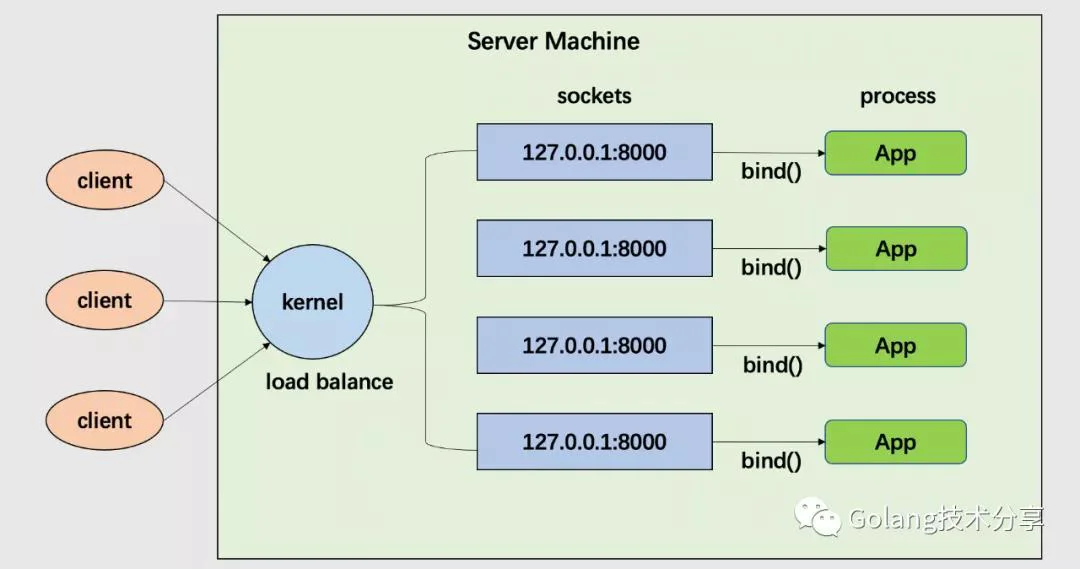
在测试 HTTP 服务时,如果该进程我们忘记关闭,而重新尝试启动一个新的服务进程,那么将会遇到类似以下的错误信息:
- $ go run main.go
- listen tcp :8000: bind: address already in use
这是由于默认情况下,操作系统不允许我们打开具有相同源地址和端口的套接字 socket。但如果我们想开启多个服务进程去监听同一个端口,这可以吗?如果可以,这又能给我们带来什么?
socket 五元组
socket 编程是每位程序员都应该掌握的基础知识。因此,大家应该知道,socket 连接通过五元组唯一标识。任意两条连接,它的五元组不能完全相同。
- {<protocol>, <src addr>, <src port>, <dest addr>, <dest port>}
protocol 指的是传输层 TCP/UDP 协议,它在 socket 被创建时就已经确定。src addr/port 与 dest addr/port 分别标识着请求方与服务方的地址信息。
因此,只要请求方的 dest addr/port 信息不相同,那么服务方即使是同样的 src addr/port ,它仍然可以标识唯一的 socket 连接。
基于这个理论基础,那实际上,我们可以在同一个网络主机复用相同的 IP 地址和端口号。
Linux SO_REUSEPORT
为了满足复用端口的需求,Linux 3.9 内核引入了 SO_REUSEPORT选项(实际在此之前有一个类似的选项 SO_REUSEADDR,但它没有做到真正的端口复用,详细可见参考链接1)。
SO_REUSEPORT 支持多个进程或者线程绑定到同一端口,用于提高服务器程序的性能。它的特性包含以下几点:
-
允许多个套接字 bind 同一个TCP/UDP 端口
- 每一个线程拥有自己的服务器套接字
- 在服务器套接字上没有了锁的竞争
- 内核层面实现负载均衡
- 安全层面,监听同一个端口的套接字只能位于同一个用户下(same effective UID)
有了 SO_RESUEPORT 后,每个进程可以 bind 相同的地址和端口,各自是独立平等的。
让多进程监听同一个端口,各个进程中 accept socket fd 不一样,有新连接建立时,内核只会调度一个进程来 accept,并且保证调度的均衡性。
其工作示意图如下

有了 SO_REUSEADDR 的支持,我们不仅可以创建多个具有相同 IP:PORT 的套接字能力,而且我们还得到了一种内核模式下的负载均衡能力。
Go 如何设置 SO_REUSEPORT
Linux 经典的设计哲学:一切皆文件。当然,socket 也不例外,它也是一种文件。
如果我们想在 Go 程序中,利用上 linux 的 SO_REUSEPORT 选项,那就需要有修改内核 socket 连接选项的接口,而这可以依赖于 golang.org/x/sys/unix 库来实现,具体就在以下这个方法。
- import “"golang.org/x/sys/unix"”
- ...
- unix.SetsockoptInt(int(fd), unix.SOL_SOCKET, unix.SO_REUSEPORT, 1)
因此,一个持有 SO_REUSEPORT 特性的完整 Go 服务代码如下
- package main
- import (
- "context"
- "fmt"
- "net"
- "net/http"
- "os"
- "syscall"
- "golang.org/x/sys/unix"
- )
- var lc = net.ListenConfig{
- Control: func(network, address string, c syscall.RawConn) error {
- var opErr error
- if err := c.Control(func(fd uintptr) {
- opErr = unix.SetsockoptInt(int(fd), unix.SOL_SOCKET, unix.SO_REUSEPORT, 1)
- }); err != nil {
- return err
- }
- return opErr
- },
- }
- func main() {
- pid := os.Getpid()
- l, err := lc.Listen(context.Background(), "tcp", "127.0.0.1:8000")
- if err != nil {
- panic(err)
- }
- server := &http.Server{}
- http.HandleFunc("/", func(w http.ResponseWriter, r *http.Request) {
- w.WriteHeader(http.StatusOK)
- fmt.Fprintf(w, "Client [%s] Received msg from Server PID: [%d] \n", r.RemoteAddr, pid)
- })
- fmt.Printf("Server with PID: [%d] is running \n", pid)
- _ = server.Serve(l)
- }
我们将其编译为 linux 可执行文件 main
- $ CGO_ENABLED=0 GOOS=linux GOARCH=amd64 go build main.go
在 linux 主机上开启三个同时监听 8000 端口的进程,我们可以看到三个服务进程的 PID 分别是 32687 、32691 和 32697。
- ~ $ ./main
- Server with PID: [32687] is running
- ~ $ ./main
- Server with PID: [32691] is running
- ~ $ ./main
- Server with PID: [32697] is running
最后,通过 curl 命令,模拟多次 http 客户端请求
- ~ $ for i in {1..20}; do curl localhost:8000; done
- Client [127.0.0.1:56876] Received msg from Server PID: [32697]
- Client [127.0.0.1:56880] Received msg from Server PID: [32687]
- Client [127.0.0.1:56884] Received msg from Server PID: [32687]
- Client [127.0.0.1:56888] Received msg from Server PID: [32687]
- Client [127.0.0.1:56892] Received msg from Server PID: [32691]
- Client [127.0.0.1:56896] Received msg from Server PID: [32697]
- Client [127.0.0.1:56900] Received msg from Server PID: [32691]
- Client [127.0.0.1:56904] Received msg from Server PID: [32691]
- Client [127.0.0.1:56908] Received msg from Server PID: [32697]
- Client [127.0.0.1:56912] Received msg from Server PID: [32697]
- Client [127.0.0.1:56916] Received msg from Server PID: [32687]
- Client [127.0.0.1:56920] Received msg from Server PID: [32691]
- Client [127.0.0.1:56924] Received msg from Server PID: [32697]
- Client [127.0.0.1:56928] Received msg from Server PID: [32697]
- Client [127.0.0.1:56932] Received msg from Server PID: [32691]
- Client [127.0.0.1:56936] Received msg from Server PID: [32697]
- Client [127.0.0.1:56940] Received msg from Server PID: [32687]
- Client [127.0.0.1:56944] Received msg from Server PID: [32691]
- Client [127.0.0.1:56948] Received msg from Server PID: [32687]
- Client [127.0.0.1:56952] Received msg from Server PID: [32697]
可以看到,20 个客户端请求被均衡地打到了三个服务进程上。
总结
linux 内核自 3.9 提供的 SO_REUSEPORT 选项,可以让多进程监听同一个端口。
这种机制带来了什么:
提高服务器程序的吞吐性能:我们可以运行多个应用程序实例,充分利用多核 CPU 资源,避免出现单核在处理数据包,其他核却闲着的问题。
内核级负载均衡:我们不需要在多个实例前面添加一层服务代理,因为内核已经提供了简单的负载均衡。
不停服更新:当我们需要更新服务时,可以启动新的服务实例来接受请求,再优雅地关闭掉旧服务实例。
如果你们的 Go 项目,一到高峰期就有请求堆积问题,这个时候就可以考虑采用 SO_REUSEPORT 选项。
参考链接:
【1. How do SO_REUSEADDR and SO_REUSEPORT differ?】https://stackoverflow.com/questions/14388706/how-do-so-reuseaddr-and-so-reuseport-differ
【2. SO_REUSEPORT 性能测试】 http://www.blogjava.net/yongboy/archive/2015/02/12/422893.html
【3. linux socket man-page】https://man7.org/linux/man-pages/man7/socket.7.html
原文链接:https://mp.weixin.qq.com/s/lnOTaraGKINxaqbrMHPP5Q
